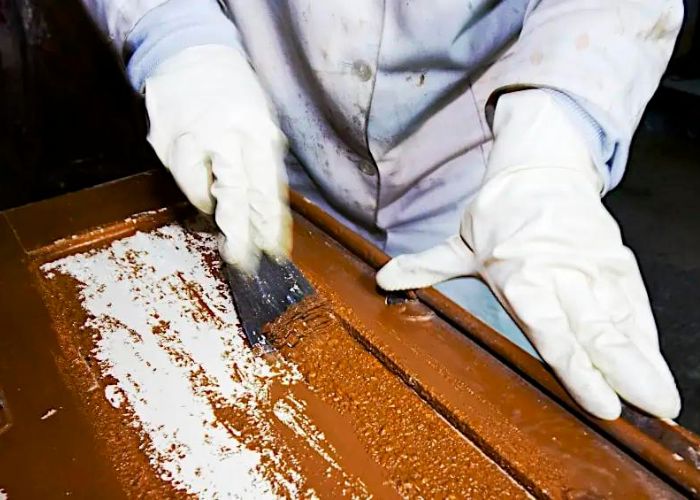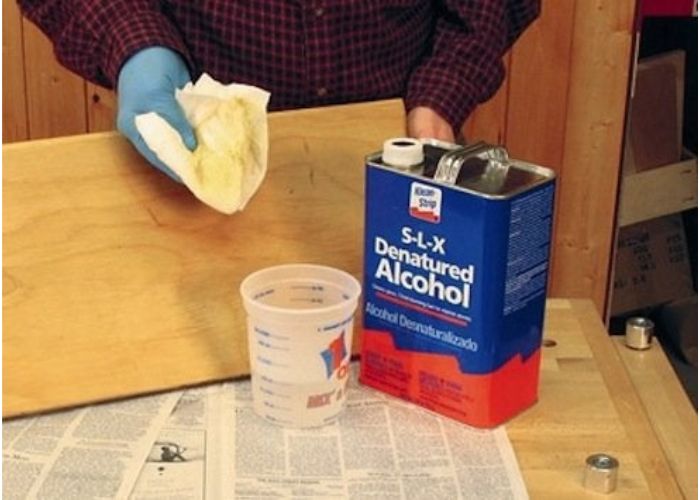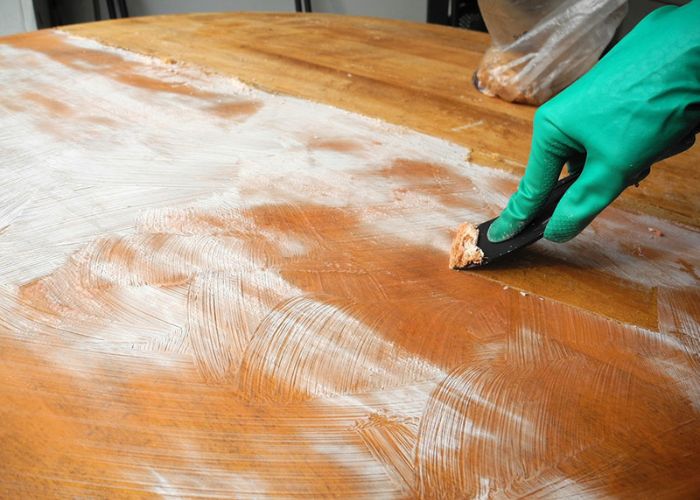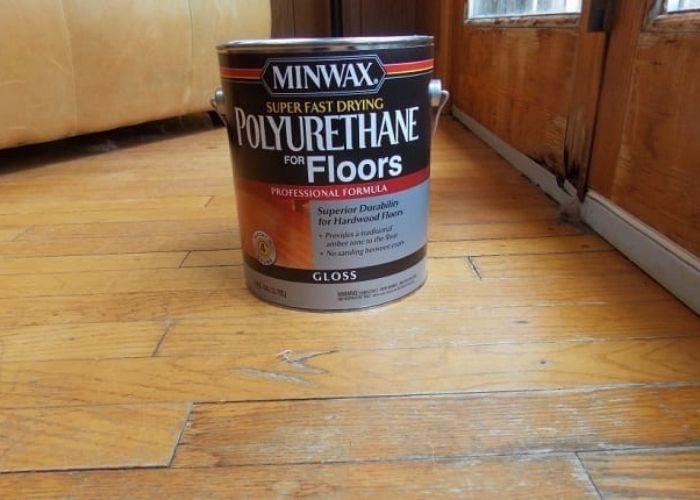Polyurethane is a type of wood finish that has become popular in recent years, but it can be difficult to remove without sanding.
However, we’ll share some tips on how to remove polyurethane from wood without sanding and damaging the surface.
It is important that the polyurethane has not been soaked into the wood furniture and it can be removed with a wet rag or steel wool.
If the polyurethane has soaked in, then use a chemical like acetone or mineral spirits and do not allow these chemicals to come in contact with your skin.
How To Remove Polyurethane From Wood Without Sanding
To remove polyurethane from wood without sanding, use citrus stripper gel and a plastic scraper to scrape it off. After 30 minutes to 24hrs, test the scrapes depending on the number of coats to be removed. Afterward, remove any residual polyurethane using a paint stripper wash. Finally, use mineral spirit to prepare the workpiece for a new polyurethane finish.
To remove polyurethane without sanding your wood, here are three methods that work well.
How to Remove Polyurethane From Wood Without Sanding – 3 Ways
To pull this successfully, take your time and have patience. The time you put in will have a profound effect on how much removal is achieved.
Method 1: Remove Poly from Wood with Paint Stripper

Here’s what you’ll need:
- Vacuum cleaner.
- Citrus stripper gel.
- Plastic scraper.
- Regular brush
- Old toothbrush (to be used for hard-to-reach corners) – Optional.
- Stripping pad (for stubborn areas) – Optional.
For your safety, ensure you have chemical-resistant gloves and chemical splash goggles.
This method requires you to work in a well-ventilated area else, work outside under a shed.
Ensure you have all the correct tools for this method except the optional ones, as polyurethane is a foaming agent for hardening textured surfaces.
Step 1: Prepare The Area Where You Will Be Working
Clean the work surface. You can do this using a vacuum or a wet/dry cloth. Once you’ve gotten all of the dirt off the surface, it’s time to get to work.
You’ll also want to cover the area you’re working with drop cloths or newspapers.
Step 2: Apply Citrus Stripper
Before applying this solution to the wood, confirm it’s sealed properly, then give it a good shake to mix it.
Pour it in a container, then use a regular paintbrush to apply the citrus paint stripper to the workpiece. A special stripper isn’t necessary.
If you are working on an irregular wood surface, use a toothbrush to apply the citrus chemical stripper to hard-to-reach corners and remove the polyurethane layer from the wooden surface.
Step 3: Wait And Test Scrape
After applying the water-based strippers to the entire workpiece, give it 30 minutes to 24 hours to soak into polyurethane.
Cover it with plastic if you’ll leave it overnight to prevent dust from settling on the workpiece.
After 24 hours, use a scraper to scrape off the poly, as this time, the citrus stripper is easy to remove.
Note: A test scrape is crucial depending on how many coats of polyurethane you need to remove. Citrus stripper removes up to 5 coats of poly for each application.
Step 4: Scrape Time
As mentioned, the amount of time you spend on the workpiece determines how well the poly will be removed, use a scraper to scrape in the direction of the wood grain once more.
If you encounter stubborn areas, dip an abrasive stripping pad in citrus stripper, then scrub the area.
Step 5: Wash It Off
Now use a paint stripper wash to remove residue that might be left on the wood surface. Follow the right stripper step.
If you want to refinish the wood surface once more, prep the wood with mineral spirits and give it time to completely dry before repainting.
Read Also: How to Remove Stains From Wood Floors
Method 2: Using Denatured Alcohol and Lacquer Thinner

Polyurethane is known for its smooth consistency, pliable consistency, and excellent adhesion properties. Use denatured alcohol and the thinner to remove poly from wood because they react chemically to soften the bond.
Here are a few items you’ll need to remove polyurethane from wood using denatured alcohol and lacquer thinner
- Denatured alcohol.
- Vacuum cleaner
- Lacquer (Can you put urethane over lacquer?)
- Stirring stick.
- Regular paintbrush.
- Fine steel wool 00 pad.
- Warm water.
- Old toothbrush – Optional
Ensure to have a heavy plastic drop cloth, rubber gloves, and goggles to protect yourself from chemical strippers.
Let’s dive in and see how to remove tough stains such as poly using this method.
Step 1: Prepare To Get To Work
Use a vacuum cleaner or a weather cloth or rag to clean the dust off the wood surface.
Also, clean the entire work area, open all the windows and doors, so you work in a well-ventilated workshop to prevent complications to your respiratory system.
Cover the area with drop cloths or magazines to prevent spilling on the floor and the working area.
Protective gloves and a face shield are essential for your safety. People suffering from asthma should have a face mask to protect them from fumes.
Step 2: Make A Mixture Of Denatured Alcohol And Lacquer Thinner
We’re using this mixture because it’s the best solution available to dissolve paint and varnish. Alcohol, on the other hand, works as a cleaning agent.
Find a plastic bucket or empty paint can, clean it, then mix one part of alcohol with one part of lacquer thinner; use a stirring stick to stir the mixture.
Note: This mixture will eliminate polyurethane from your workpiece without removing the underlying paint or varnish.
Step 3: Use The Mixture To Remove Polyurethane
When the mixture is uniformly mixed, and there’re no patches of the two solutions, use a regular paintbrush to apply this combination to the wood that needs polyurethane removed.
Use thick coats and more than two strokes to cover poly and have it soak quickly.
Use an old toothbrush to reach the corners of non-flat wood surfaces.
Step 4: Remove The Mixture using Fine Steel Wool
Polyurethane needs 10 seconds to soak. To break its adhesive, you can give it more time, up to 30 seconds or 1 minute.
Next, rub in the direction of the grain using the steel wool 00 pad. Go through the area several times till the workpiece is completely stripped well, then move to the next step.
Step 5: Clean The Wood With Warm Water
Now that the poly has been stripped off the workpiece in the above step, it’s time to clean the wood.
Clean the wood using a wood cleaner, then wash the wood with warm water, dry the wood then later use mineral spirit to prep the wood for another polyurethane finish if needed.
Interesting read: What is the best non-yellowing polyurethane?
Method 3: Use Baking Soda And Vinegar If You Don’t Want To Use Harsh Chemicals
We have all heard of people using baking soda and vinegar to remove paint from their furniture, but does vinegar remove paint from wood?
The answer is yes. But first, you need to assemble all the necessary tools;
- Baking soda.
- Vinegar.
- Cornstarch.
- Hot water.
- Vacuum cleaner.
- Stirring stick.
- Regular paintbrush.
- Wire brush or steel wool 00 pad.
- 60, 80, and 120 grit assorted sandpapers (Optional).
Step 1: Prepare The Mixture
Prepare your work area, ensuring it’s dust-free.
Mix soda, cleaning vinegar, and cornstarch as instructed below.
Make a mixture of the following:
- Four cups of hot water.
- 1 cup of cornstarch.
- A bowl with a half cup of cold water.
A thick paste will be formed.
Using another bowl, add 4 cups of water to it, then add one tablespoon of vinegar and half a cup of soda to it.
Stir this mixture using a stirring stick, then add it to the first mixture you prepared and stir it well.
Step 2: Apply The Mixture With A Paintbrush
Once the mixture is ready, use a paintbrush to apply it to the workpiece. Give it a few minutes, about 5 to 10 minutes, for the mixture to sit in the wood.
Next, scrub the wood surface using a wire brush for painting. Don’t put in too much pressure as you might damage the wood.
Instead, you can use a steel wool 00 pad to dry it using a hairdryer or leave it to the sun.
Step 3: Sand The Wooden Surface in the Direction of Wood Grain
Sanding in this method isn’t intended to remove poly, but it’s a precaution to prep the wood for the next refinish.
It’s also necessary if you use a wire brush in step 2.
Start with the 60-grit sandpaper to restore the natural color of the wood – always sand towards the direction of the grain.
Next, using less effort, shift to the 80-grit sandpaper to smoothen the wood.
Finish up with 20-grit fine sandpaper for the best results and use a dry and clean rag to clean the wood. You can use a vacuum cleaner or a wood cleaner if you have one too.
Learn More: Tips for Getting Rid of Black Urine Marks on Hardwood Floors
Can You Sand Off Polyurethane?

A lot of people wonder if you can sand off polyurethane from the furniture.
What I tell them is among the most popular DIY projects because it can save you a lot of money, and it’s also a fast DIY project.
But if you want to know if you can sand off polyurethane or not, then read on. Here are some details about the process of sanding off polyurethane.
Removing polyurethane wood from the surface is achievable in different ways. But chemical strippers are pretty good at removing polyurethane left in wood. This chemical is toxic. Therefore, never try to take this chemical by yourself without knowing everything about it.
The safest way is to use sandpaper on a sanding machine. However, this method requires high energy. In addition, some machines require two or more cycles of sanding before it would start working correctly – sanding machines can be pretty costly.
Another method used by many is water-based sanding. But this method is more complicated. In addition, it’s less effective compared to machine-based dry sanding.
Read also: How to choose polyurethane finishes for wood floors.
Quick Tips
- Before you sand off polyurethane from wooden floors, make sure the surface is well-cleaned. If you don’t clean the floor, you will have difficulties removing it.
- Before you begin sanding, buy or rent some good sandpaper. There’re different grades of sandpaper you can use for different tasks but for this, use the 120-grit sandpaper or 150-grit sandpaper.
- For instance, if you don’t want sandpaper, you can purchase an electric sander to remove paint from wood. In addition, you need rubber gloves, a dust mask, and an air compressor for making air streams to apply pressure during the whole stripping process. You should start sanding the surface of your furniture using the lowest speed you can manage with your sander. When removing polyurethane from wood, it’s best to wear a face mask because you might inhale the fumes emitted by the chemical.
Interesting read: How to apply polyurethane on wood floors.
Tips for Removing Polyurethane From Wood Surface
Before attempting to remove poly from wood, confirm the following:
- Ensure you prepare the surfaces to be treated with the chemical. These can include floorboards and other surfaces, as well as the surrounding surfaces.
- Ensure the workpiece is dry.
- If using a dry clean cloth, the alcohol will already have soaked in. In the next step, you will need to stir the mixture. Continue stirring the mixture with a wooden stick until it has completely dispersed. When you are satisfied, remove the mixture from its container. Your bare wood surface will need to be wet with the mixture but not soaking wet.
- If your wood has been previously treated with a protective coating, you should remove this before you attempt to remove polyurethane. Most products will advise you to do this, but you may not have this option if not added.
- Once you have added the citrus stripper to the water, you need to scrub it onto the surface. Be careful when working with this substance, as it can become toxic. A scraper is a great product to use for this step since it’s designed to safely scrape the substance without harm being done to your hands or skin. (Here’s how to get polyurethane off hands.)
FAQs
1. What is the best way to remove polyurethane from wood?
The best way to remove poly from wood is by mixing denatured alcohol with lacquer thinner. It’s the best combination for stripping polyurethane. However, you must wear protective gear if you follow this approach.
2. How does vinegar remove polyurethane?
Polyurethane is removed from wood by vinegar when the acid in the vinegar breaks down the bond or adhesion created between poly and the underlying paint.
3. Does acetone remove polyurethane?
Yes, acetone can remove most paints and finishes but can sometimes damage the workpiece. It’s ok to use polyurethane but avoid solvent-resistant finishes, e.g., softened varnish, UV-cured finish, two-part polyurethane, and epoxy resin.
Read more: Can I polyurethane over epoxy?
4 Can you use a heat gun to remove polyurethane?
Yes, you can employ heat guns to remove polyurethane on your wooden surface. This doesn’t require any special skills.
Final Thoughts
As you’ve seen, it’s possible to remove polyurethane from wood without sanding.
However, the most effective and fastest way to remove poly from wood without getting stained is to use the “sandpaper technique.” This method will require a power sander to achieve the results you are looking for, but it’s one of the least expensive options you have.
I also recommend using soda and vinegar if you don’t want to use strong chemicals.
To ensure a cautious approach during the removal process, I recommend reading our informative article titled “Is polyurethane toxic to humans?” This will provide you with valuable insights and guidance.


Hello Goodell,
I wish I had read this great article a little more closely. I missed the part about working the stripper into the wood. What I did was applying it and the next day to scrape it off.
The result: hardly a difference or as if I never used it at all.
Now, I tried your recipe with denatured alcohol and paint thinner and followed each ingredient and steps to the letter.
Result: same as the stripper.
Sanding: using all grits with both a Dewalt palm grip sander and a Dewalt orbital sander. They got most of the surface back doen to raw wood.
I should have mentioned at first that my issue is the removal of the stubborn poly along the edges and corners of a wood cabinet.
Using the above methods and by placing cabinet in the ideal position for best sanding results still couldn’t get some stains removed.
I don’t know if the previous owner of the cabinet used a certain stain or protection which has aged or a mixture of paints with lacquer that caused an extreme bond which renders us to tears.
You must understand that I’m funny about my work to a point of reaching perfection or you won’t see your property until I’m satisfied.
The owner of said cabinet is my cousins. And still, I will not return it to him until I’ve exhausted all possible avenues for success.
I enjoy, maybe too subtle of a description, woodworking so much that I’ve amassed many tools in such a short time. I recall my fondness for it back in shop at Middle School.
Besides the sanders, there’s a Dewalt table saw, Dewalt sliding, dual bevel miter saw, Dewalt reciprocating saw, Dewalt drill, Dewalt impact drill to name a few. As you see, I’m partial towards Dewakt tools.
I’ve given you my inventory for you to suggest an essential tool you suggest I am missing.
I appreciate you reading my message and the patience with my issue.
Sincerely,
Michael Realme
Interesting. I’m having a similar problem with refinishing my kitchen cabinets. Only I’m the one who put the original finish on, 37 years ago. I can’t remember what it is but multiple coats of stripper and it’s not coming off well. Wish he’d replied here. He has a lot of knowledge.